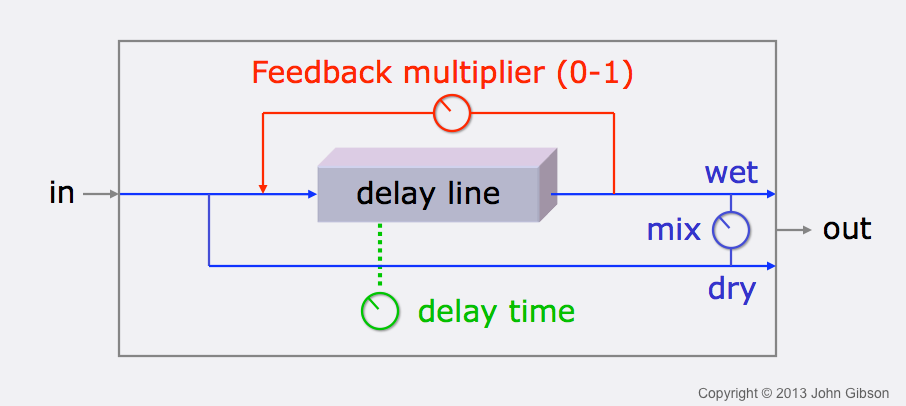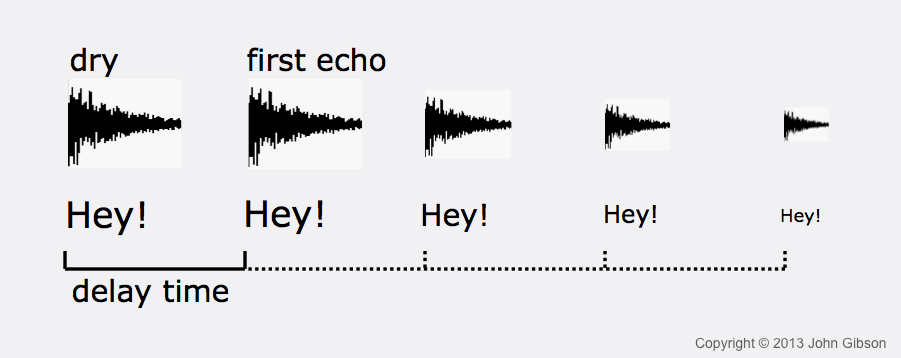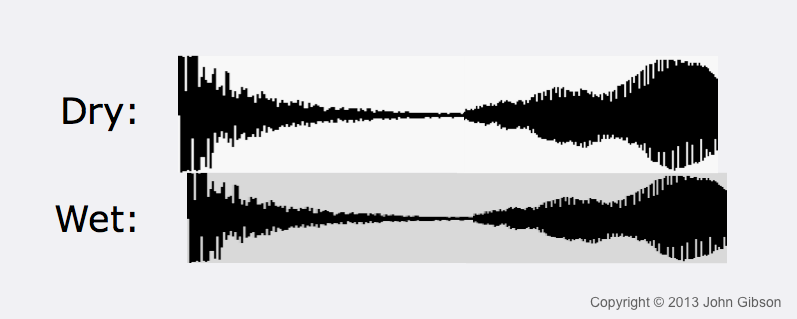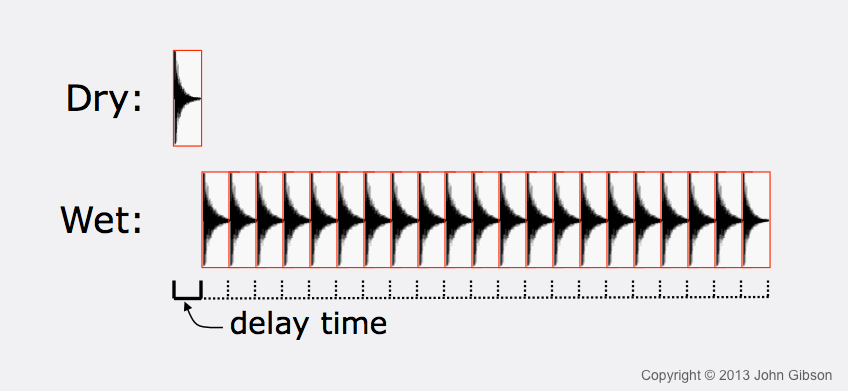You are probably familiar with the typical use of a delay effect: to create a series of echoes, each echo softer than the last. Although this is the most common manifestation of delay, it is not the only one. In this lesson, you will learn the basic operation and parameters of a simple delay effect. Then we’ll look at some of the ways you can use this effect.
Reason: Delay Effects
The Structure of a Delay Effect
All delay effects, even the most complex, are made from the following basic structure.

Sound enters the effect on the left, where it splits into two parts: the wet, or delayed, signal, and the dry, or unaffected, signal. Usually there is a control, commonly known as the wet/dry mix, that lets you balance these two signals. The box in the middle represents the delay line, a storage area for sound. Individual audio samples enter the delay line one at a time and emerge after a certain amount of time, the delay time. This time value can be expressed in clock time, usually milliseconds, or in musical time, as rhythmic note values (1/4, 1/8, etc.). This lets you synchronize echoes with the rhythms in your music.
As sound exits the delay line, it splits into two paths. One path goes to the output, to be balanced with the dry signal. The other path feeds back into the entrance of the delay line. There is always a scale factor that governs the strength of the feedback signal. Internally, this is a value between 0 and 1, but the effect user sees a percentage, from 0 to 100%.
| Parameter | Description |
|---|---|
| Delay time | how long to delay input signal |
| Feedback | how much output to send back into input |
| Wet/dry mix | balance between original and delayed signal |
A Simple Delay Effect in Reason
The DDL-1 Digital Delay Line available in Reason is a straightforward implementation of the basic delay structure described above.

You set delay time on the left side, in either milliseconds (MS) or musical note values (STEPS), depending on the UNIT selection. If UNIT is set to STEPS, you can choose either a sixteenth note or a triplet eighth for the step length. Then the delay time readout to the left sets the number of these notes that add up to the delay time. For example, if you wanted your echoes to repeat at intervals of a dotted eighth — a common value for electronic dance music — then you would set the step length to 1/16, and set the number of steps in the delay readout to 3 (because there are three sixteenth notes in one dotted eighth).
In the DDL-1, feedback and wet/dry mix are set using the 0-127 MIDI value range, so you have to translate that into the more common 0-100% range.
The PAN control lets you pan the wet signal to any location in the stereo field, while the dry signal stays in the middle. Note that if you send stereo input into the DDL-1, it will sum the two channels to mono before sending this signal into the delay line.
Delay Recipes
So what can you do with this thing? Below are recipes for three important delay applications: discrete echoing, thickening, and resonating.
Discrete Echoes
When you stand on one side of the Grand Canyon and shout, your sound travels to the other side, bounces back, and returns to you. It takes any sound nearly one millisecond to travel one foot, so that determines how long it takes for your shout to return to you. If the sound were to bounce again off your side of the canyon and retrace its path, you would hear later a second, though softer, echo.
Discrete echoes like this are ones that are far enough apart that you can easily hear them individually. So to create these echoes, your delay time has to be sufficiently long: at least a tenth of a second.

The first sound you hear is the original dry signal, with no delay. Once the delay time elapses, you hear the first echo. If the wet/dry mix is 50%, this echo will have the same amplitude as the original sound.
To hear repeats, there must be feedback. Otherwise, after the first echo emerges from the delay line, there can be no more sound. The higher the feedback, the louder are the echoes. The feedback amount indirectly determines the number of echoes you hear. If the feedback is 100%, the echoes will never stop.
| Parameter | Values |
|---|---|
| Delay time | > 100 milliseconds |
| Feedback | > 0% |
| Wet/dry mix | 1-50% * |
* If using this kind of delay as a Send Effect, then set the wet/dry mix on the effect to 100%, and adjust this balance instead by using the Send knob on the mixer channel strip.
A Thickening Agent
When we listened in class to the opening of the Beatles’ “Day Tripper,” we heard a clear example of double tracking in the introductory guitar riff: doubling a melody with a slightly different performance. This makes the melody sound thicker.
A digital delay effect lets us simulate this kind of thickening, not by performing a melody twice, but by playing a slightly delayed copy of the melody. This time-shift creates some of the same complexities in the sound (namely, constructive and destructive interference between two similar waveforms) that double tracking imparts. The delay time must be shorter than that required to produce a discrete echo. Feedback is off — there is only one copy of the original sound.

In pop music of all kinds, it is very common to thicken vocal and other melodies in this manner. This kind of delay is always patched as an insert effect, not a send effect.
| Parameter | Values |
|---|---|
| Delay time | 20-100 milliseconds |
| Feedback | 0% |
| Wet/dry mix | 50% |
A similar application is the slapback echo, where the delay time is a bit longer (100-200 milliseconds), but there is still no feedback, so only a single, barely discrete echo. The wet level is a bit lower than the dry level, to keep things from getting too muddy.
Resonators
An unusual application of a delay effect is to impose a clear pitch on an input sound. A resonator is a container — for example, an instrument cavity (guitar box), or a room — that reinforces certain frequencies that sound within it. This happens because the wavelengths of those frequencies fit cleanly within the dimensions of the resonator.
The delay effect lets us simulate this behavior in a simple, and possibly greatly exaggerated, manner. If you use a delay time that is very short — less than 50 milliseconds — and a lot of feedback, then you set up the situation depicted below.

The delay time is so short that the repeated echoes of the input sound generate a periodic waveform — one cycle of the periodic waveform per echo. As we know from our acoustics study, a periodic waveform gives rise to a sense of pitch. The frequency of this pitch is the reciprocal of the delay time. That is, the delay time is the period of one cycle. For example, if the delay time is 10 milliseconds (0.010 seconds), the frequency produced is 1 / 0.01 = 100 Hz. (This is the G at the bottom of the bass staff.) All of the harmonic partials of this fundamental frequency are also present, which is why the effect is quite bright and buzzy.
To get strong repetitions of the input signal, the feedback must be quite high. The higher it is, the stronger the sense of imposed pitch. When it is above 98%, the sound rings freely and might clip, if a frequency in the input signal is reinforced by the resonator frequency and its harmonic partials.
| Parameter | Values |
|---|---|
| Delay time | < 50 milliseconds |
| Feedback | > 90% |
| Wet/dry mix | > 10% |
Some delay effects let you flip the phase of the feedback signal (by allowing negative feedback), which produces a different timbre for a resonator.
The trouble with producing this effect in Reason is that it is not possible to request non-integer delay times, so you can’t tune the resonated pitch precisely. This may or may not be a problem, depending on the musical context.
Common Enhancements to Delay Effects
One of the more common enhancements to a delay effect is to allow for some processing of the feedback signal. Many delay effects provide a filter in the feedback path, which causes echoes to have a spectral shape that is different from that of the dry sound.
In Reason, The Echo is a complex delay effect that models the behavior of analog tape delays, such as the Echoplex, made famous by Jimi Hendrix and others in the 1960s. The Echo includes a filter and distortion unit in the feedback path, as well as jacks on the back of the device that let you patch anything into the feedback path.
Instead of setting the delay time and leaving it, you can modulate the delay time, so that it always changes. (To review the concept of modulation, run the interactive Modulation app.) If you take the simple resonator effect recipe given above, and modulate the delay time, this creates a flanger, which produces an airy, swirling sound. In Reason, there is a dedicated device to perform flanging: the CF-101 Chorus/Flanger.
Finally, musicians often use multiple delay taps, or different simultaneous delay times, for the same delay line, or they interconnect multiple delays in complicated ways.
As a relatively simple example in Reason, you can send the output of a synthesizer into two DDL-1 devices. (The Spider Audio Merger & Splitter lets you split one signal into two copies, which you can then send to two different places.) If you pan the two DDL-1 devices to opposite sides of the stereo field, and give the two devices different delay times, you can create an interesting stereo effect. This is especially useful for the SubTractor synthesizer, because it does not have stereo output.

